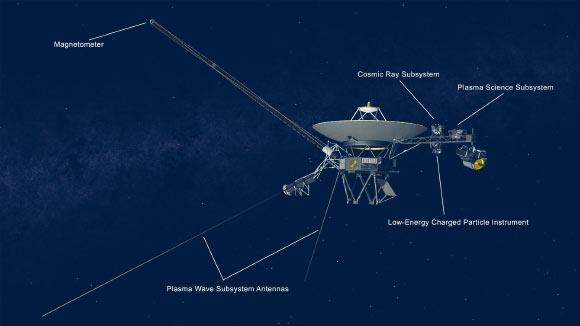Launched in September 1977, NASA’s Voyager 1 spacecraft flew by Jupiter in 1979 and then Saturn in late 1980. In August 2012, it crossed the heliopause and became the first in situ probe of the very local interstellar medium. Now, using data from the Plasma Wave System on Voyager 1, a team of researchers from Cornell University and the University of Iowa has detected very weak plasma wave emission in the interstellar medium.
Source: Sci News
Like the ocean, the interstellar medium is full of turbulent ‘waves.’
The largest come from our Milky Way Galaxy’s rotation, as space smears against itself and sets forth undulations tens of light-years across.
Smaller ripples rush from supernova blasts, stretching billions of km from crest to crest.
The smallest waves are usually from our Sun, as solar eruptions send shockwaves through space that permeate our heliosphere’s lining.
These crashing waves reveal clues about the density of the interstellar medium — a value that affects our understanding of the shape of our heliosphere, how stars form, and even our own location in the Galaxy.
As these waves reverberate through space, they vibrate the electrons around them, which ring out at characteristic frequencies depending on how crammed together they are. The higher the pitch of that ringing, the higher the electron density.
Voyager 1’s Plasma Wave System, which includes two antennas sticking out 10 m (30 feet) behind the spacecraft, was designed to hear that ringing.
“It’s very faint and monotone, because it is in a narrow frequency bandwidth,” said Stella Koch Ocker, a Ph.D. student in the Department of Astronomy and the Cornell Center for Astrophysics and Planetary Science at Cornell University.
“We’re detecting the faint, persistent hum of interstellar gas.”
“This work allows scientists to understand how the interstellar medium interacts with the solar wind, and how the protective bubble of the Solar System’s heliosphere is shaped and modified by the interstellar environment.”
In November 2012, three months after exiting the heliosphere, Voyager 1 heard interstellar sounds for the first time.
Six months later, another ‘whistle’ appeared — this time louder and even higher pitched. The interstellar medium appeared to be getting thicker, and quickly.
These momentary whistles continue at irregular intervals in Voyager’s data today.
“They’ve only been seen about once a year, so relying on these kind of fortuitous events meant that our map of the density of interstellar space was kind of sparse,” Dr. Ocker said.
Dr. Ocker and colleagues set out to find a running measure of interstellar medium density to fill in the gaps — one that doesn’t depend on the occasional shockwaves propagating out from the Sun.
After filtering through the Voyager 1 data, looking for weak but consistent signals, they found a promising candidate. It started to pick up in mid-2017, right around the time of another whistle.
“It’s virtually a single tone. And over time, we do see it change — but the way the frequency moves around tells us how the density is changing,” Dr. Ocker said.
The scientists call the new signal a plasma wave emission, and it, too, appeared to track the density of interstellar medium.
When the abrupt whistles appeared in the data, the tone of the emission rises and falls with them.
The signal also resembles one observed in Earth’s upper atmosphere that’s known to track with the electron density there.
“This is really exciting, because we are able to regularly sample the density over a very long stretch of space, the longest stretch of space that we have so far,” Dr. Ocker said.
“This provides us with the most complete map of the density and the interstellar medium as seen by Voyager.”
Based on the signal, electron density around Voyager 1 started rising in 2013 and reached its current levels about mid-2015, a roughly 40-fold increase in density.
The spacecraft appears to be in a similar density range, with some fluctuations, through the entire dataset they analyzed which ended in early 2020.
“We’ve never had a chance to evaluate it. Now we know we don’t need a fortuitous event related to the Sun to measure interstellar plasma,” said Dr. Shami Chatterjee, a researcher in the Department of Astronomy and the Cornell Center for Astrophysics and Planetary Science at Cornell University.
“Regardless of what the Sun is doing, Voyager is sending back detail. The craft is saying, ‘Here’s the density I’m swimming through right now. And here it is now. And here it is now. And here it is now.’ Voyager is quite distant and will be doing this continuously.”
The results were published online this week in the journal Nature Astronomy.
Source: Sci News

































Leave a Comment
You must be logged in to post a comment.